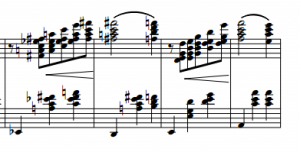In my last post, I said “Truly triple waltzes are an impossibility. They shouldn’t exist, and they don’t”. Less than 48 hours later, while I was playing Ich weiß nicht zu wem ich gehöre for a warm-up tendu, I realised I was wrong. There are examples of waltzes in truly triple metre, and I’d just played one. These useful, slow, “English” waltzes are very common in German 1930s songs for some reason – Vom Kopf bis Fuß (Falling in love again), Ich weiß es wird einmal ein Wunder geschehen, Leben ohne Liebe kannst du nicht. Truly triple songs in English include The boy next door (from Meet me in St Louis), Would you? (from Singing in the Rain), What’ll I do.
But how many of those examples can we say are truly truly triple metre? If you take the position of cadences as the giveaway (i.e. for it to be truly triple, they must come on 8, not 7), then only Falling in Love Again qualifies (though Would you? meets the criterion in the first three lines). Their feel is more triple than other waltzes, but it’s only a feel, not a structural fact. Look more closely at Vom Kopf bis Fuß, the only truly truly triple ‘waltz’ of the ones I listed, and you’ll see that the cadences fall on the second beat of the bar, mazurka-style (or more appropriately, given the tempo, kujawiak-style). So the truly-triple-waltz turns out, in fact, to be more like a kujawiak, which we knew was triple already.

So apart from the waltz-which-is-really-a-kujawiak, are there any truly triple waltzes, contrary to what I said in my earlier post? One very strong contender is Nazareth’s Adieu – Romance sem palavras, which we used for pliés in the RAD’s new Grade 5. It works wonderfully for Adages in a very slow 3, because it’s calm and measured, and wears its three-ness on the surface, so you get a clear sense of timing. And it really is in three – the cadences are on 8, not 7. Adieu is a strange example, though. The first four bars of the melody strongly suggest a 6/8 hypermeter, but the next four emphasise each bar individually, and reverse the accentuation of the hypermeter established in the preceding phrase, so that the weakest bars now receive the strongest accent. What’s more, whereas the harmonic change happened over two-bar spans in bars 1-4, in bars 6 and 8, that change is compressed into a single bar in a weak position. That’s a lot of metrical interest for an 8 bar phrase, and is perhaps why it works so well for complex ballet exercises where a lot is happening in a short space of time.
Update (26/9/14) Re-reading what I’ve written about Adieu, I think it’s hard to make a case for it being “truly triple” except for the fact that the final cadence is on 8 rather than 7. Otherwise, though, it’s hypermetrically duple. The feeling that it is triple comes, I think, from the fact that the harmony frequently changes every bar, or at times, within the bar at quarter-note level.
The chorus of Feed the Birds from Mary Poppins is truly triple, apart from the middle eight, but I can’t think of many more – can you?

